The NVIDIA GeForce GTX Titan X Review
by Ryan Smith on March 17, 2015 3:00 PM ESTCompute
Shifting gears, we have our look at compute performance.
As we outlined earlier, GTX Titan X is not the same kind of compute powerhouse that the original GTX Titan was. Make no mistake, at single precision (FP32) compute tasks it is still a very potent card, which for consumer level workloads is generally all that will matter. But for pro-level double precision (FP64) workloads the new Titan lacks the high FP64 performance of the old one.
Starting us off for our look at compute is LuxMark3.0, the latest version of the official benchmark of LuxRender 2.0. LuxRender’s GPU-accelerated rendering mode is an OpenCL based ray tracer that forms a part of the larger LuxRender suite. Ray tracing has become a stronghold for GPUs in recent years as ray tracing maps well to GPU pipelines, allowing artists to render scenes much more quickly than with CPUs alone.
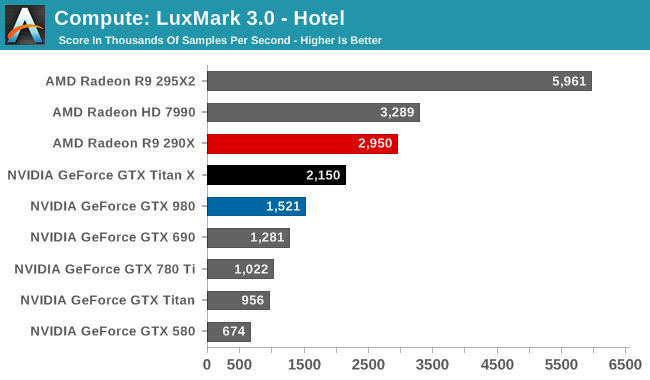
While in LuxMark 2.0 AMD and NVIDIA were fairly close post-Maxwell, the recently released LuxMark 3.0 finds NVIDIA trailing AMD once more. While GTX Titan X sees a better than average 41% performance increase over the GTX 980 (owing to its ability to stay at its max boost clock on this benchmark) it’s not enough to dethrone the Radeon R9 290X. Even though GTX Titan X packs a lot of performance on paper, and can more than deliver it in graphics workloads, as we can see compute workloads are still highly variable.
For our second set of compute benchmarks we have CompuBench 1.5, the successor to CLBenchmark. CompuBench offers a wide array of different practical compute workloads, and we’ve decided to focus on face detection, optical flow modeling, and particle simulations.
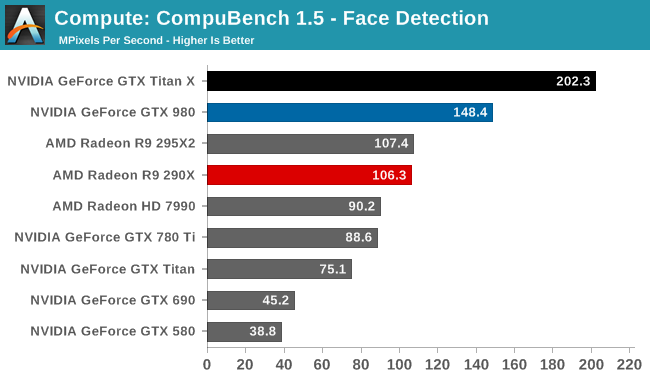
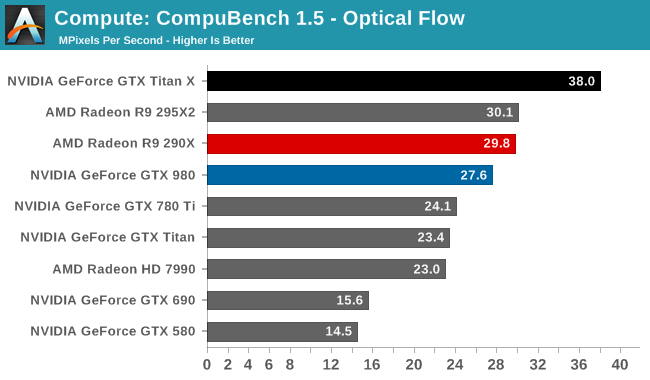
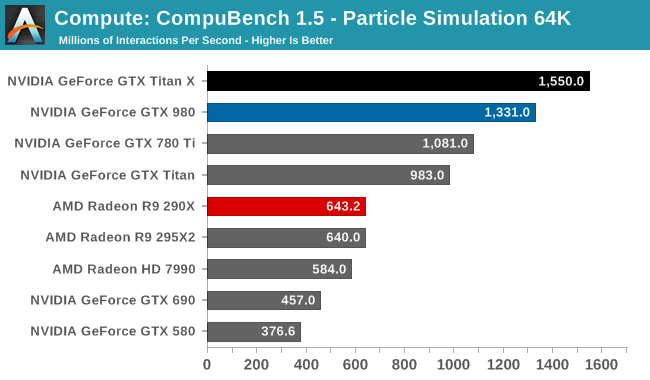
Although GTX Titan X struggled at LuxMark, the same cannot be said for CompuBench. Though the lead varies with the specific sub-benchmark, in every case the latest Titan comes out on top. Face detection in particular shows some massive gains, with GTX Titan X more than doubling the GK110 based GTX 780 Ti's performance.
Our 3rd compute benchmark is Sony Vegas Pro 13, an OpenGL and OpenCL video editing and authoring package. Vegas can use GPUs in a few different ways, the primary uses being to accelerate the video effects and compositing process itself, and in the video encoding step. With video encoding being increasingly offloaded to dedicated DSPs these days we’re focusing on the editing and compositing process, rendering to a low CPU overhead format (XDCAM EX). This specific test comes from Sony, and measures how long it takes to render a video.

Traditionally a benchmark that favors AMD, GTX Titan X closes the gap some. But it's still not enough to surpass the R9 290X.
Moving on, our 4th compute benchmark is FAHBench, the official Folding @ Home benchmark. Folding @ Home is the popular Stanford-backed research and distributed computing initiative that has work distributed to millions of volunteer computers over the internet, each of which is responsible for a tiny slice of a protein folding simulation. FAHBench can test both single precision and double precision floating point performance, with single precision being the most useful metric for most consumer cards due to their low double precision performance. Each precision has two modes, explicit and implicit, the difference being whether water atoms are included in the simulation, which adds quite a bit of work and overhead. This is another OpenCL test, utilizing the OpenCL path for FAHCore 17.
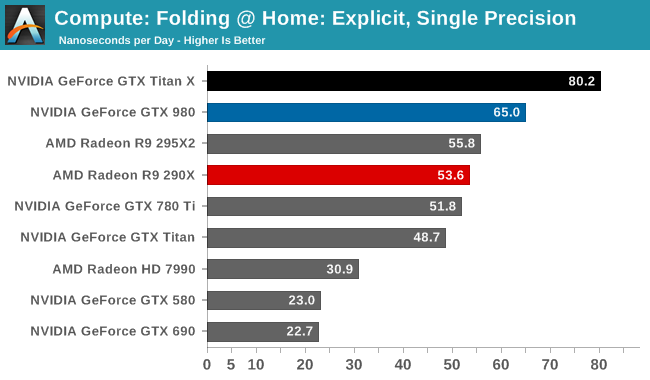
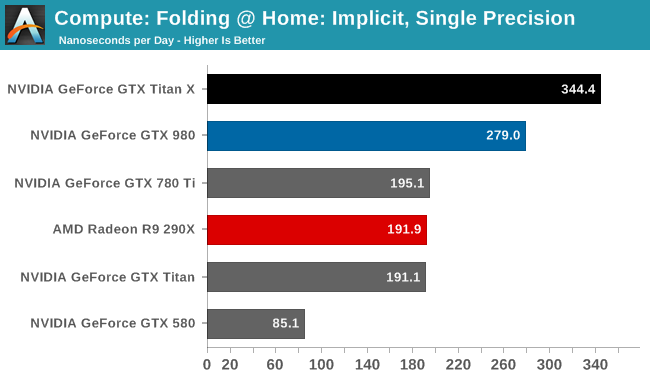
Folding @ Home’s single precision tests reiterate just how powerful GTX Titan X can be at FP32 workloads, even if it’s ostensibly a graphics GPU. With a 50-75% lead over the GTX 780 Ti, the GTX Titan X showcases some of the remarkable efficiency improvements that the Maxwell GPU architecture can offer in compute scenarios, and in the process shoots well past the AMD Radeon cards.
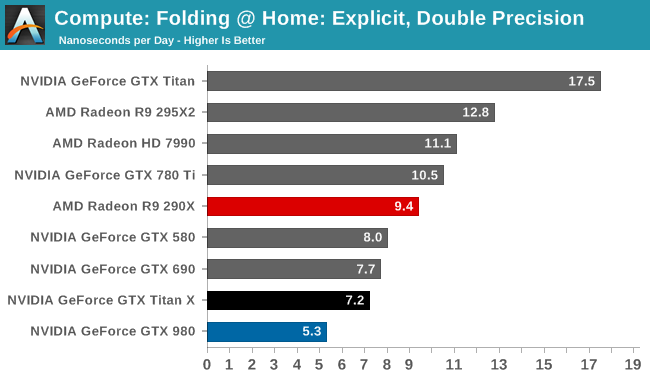
On the other hand with a native FP64 rate of 1/32, the GTX Titan X flounders at double precision. There is no better example of just how much the GTX Titan X and the original GTX Titan differ in their FP64 capabilities than this graph; the GTX Titan X can’t beat the GTX 580, never mind the chart-topping original GTX Titan. FP64 users looking for an entry level FP64 card would be well advised to stick with the GTX Titan Black for now. The new Titan is not the prosumer compute card that was the old Titan.
Wrapping things up, our final compute benchmark is an in-house project developed by our very own Dr. Ian Cutress. SystemCompute is our first C++ AMP benchmark, utilizing Microsoft’s simple C++ extensions to allow the easy use of GPU computing in C++ programs. SystemCompute in turn is a collection of benchmarks for several different fundamental compute algorithms, with the final score represented in points. DirectCompute is the compute backend for C++ AMP on Windows, so this forms our other DirectCompute test.
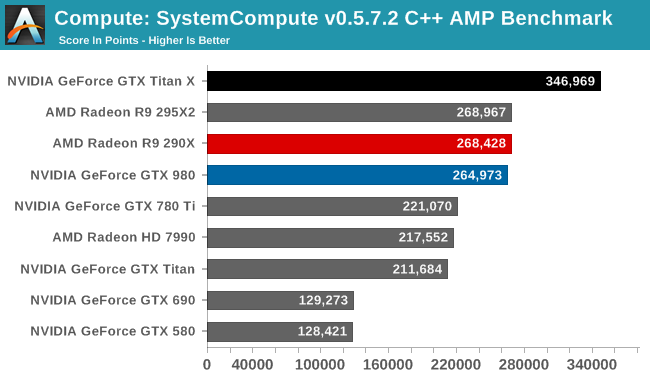
With the GTX 980 already performing well here, the GTX Titan X takes it home, improving on the GTX 980 by 31%. Whereas GTX 980 could only hold even with the Radeon R9 290X, the GTX Titan X takes a clear lead.
Overall then the new GTX Titan X can still be a force to be reckoned with in compute scenarios, but only when the workloads are FP32. Users accustomed to the original GTX Titan’s FP64 performance on the other hand will find that this is a very different card, one that doesn’t live up to the same standards.










276 Comments
View All Comments
chizow - Tuesday, March 17, 2015 - link
AMD fanboys went apeshit when AT used non-ref cooled GTX 460s that showed those cards in better light than the reference coolers, AMD fanboys need to pick a story and stick to it tbh.evolucion8 - Tuesday, March 17, 2015 - link
Ahh, we can't never miss your daily dose of AMD bashing under any GPU article, thanks for the fun.shing3232 - Tuesday, March 17, 2015 - link
Yep, it is quite entertaining.Kutark - Tuesday, March 17, 2015 - link
Entertaining but still accurate. Fanbois are fanbois, they're stupid regardless of what side of the isle they're on.chizow - Tuesday, March 17, 2015 - link
Like I said, happy to keep the AMD fanboys honest. as I did again here.Stuka87 - Tuesday, March 17, 2015 - link
That had nothing to do with non-ref cooled 460's. It was using FTW versions, which were heavily overclocked vs stock clocked AMD cards. It had nothing to do with what cooler was on them. Just the overclocked being portrayed as though they were standard edition cards. The article was later changed as I recall to state that they were overclocked cards and not stock 460s.chizow - Wednesday, March 18, 2015 - link
Its the same difference, the AMD cards are no more "stock" with custom coolers than those FTW editions. AMD baked an overclock into their boost that they weren't able to sustain without extravagant cooling. And when I mean extravagant cooling, I am talking about the Cadillac Aluminum Boat we used to be like "Oh wow, maybe one day I will fork out $60 for that massive Arctic Cooling cooler".So yeah, now you get "stock clocked, stock cooled reference cards", if you want AMD to show better in benchmarks, have them design either 1) better cooling or 2) less power hungry cards.
chizow - Tuesday, March 17, 2015 - link
@Ryan, we can't revisit all the nerdrage and angst from AMD fanboys over EVGA sending you non-reference cooled GeForce cards because they were too good over reference? Funny what happens when the shoe is on the other foot!My solution: AMD should design cards that are capable of comfortably fitting within a 250W TDP and cooler designed to dissipate that much heat, and not have to resort to a cooler that looks like an Autobot. I'm not kidding, briefly owned a Sapphire Tri-X 290X and the thing doubles as its own appliance.
Stuka87 - Tuesday, March 17, 2015 - link
Stop stating that it was because of the cooler. As I mentioned above, FTW cards are heavily overclocked and should not be portrayed as standard edition cards.MrSpadge - Tuesday, March 17, 2015 - link
Go back and read that article. The factory-OC was clearly stated.